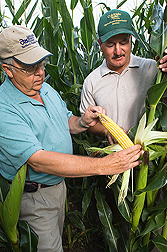|
Read the
magazine
story to find out more. |
|

More fertilizer
doesn't always equal more profit, according to a 10-year study conducted by the
Agricultural Research Service. Click the image for more information about
it.
|
|

|
Less Nitrogen Could Increase Profit, Sustainability
By Laura
McGinnis February 18, 2009
More fertilizer doesn't always mean more profit. That's one conclusion
from a 10-year study conducted by Agricultural Research Service (ARS)
scientists at the agency’s
Soil
Plant Nutrient Research Unit in Fort Collins, Colo., and colleagues at
Colorado State University.
From 1998 to 2008, the researchers evaluated and compared potential
management strategies for reducing nitrogen and nitrate nitrogen levels in soil
and groundwater.
The research, led by ARS soil scientist
Ardell
Halvorson, focused on irrigated cropping systems in the Arkansas River
Valley, an agricultural region of Colorado that has high levels of nitrate
nitrogen in the fields and groundwater--due, in part, to heavy application of
nitrogen fertilizer and the prevalence of shallow-rooted crops such as
onions.
The first study showed that onions used only about 12 to 15 percent of
the fertilizer nitrogen applied to the crop. Much of the remainder stayed in
the top six feet of soil. The next year, Halvorson and his colleagues planted
corn on the same land and found that it recovered about 24 percent of the
fertilizer nitrogen that had been applied to the onion crop.
Following that study, the scientists grew alfalfa on the land for five
years, then followed it with a watermelon crop, followed by a corn crop. In the
first year that the corn was grown, an unfertilized control plot yielded about
250 bushels of corn.
By comparison, a plot fertilized with 250 pounds of nitrogen per acre
yielded about 260 bushels, a small increase that required a significantly
higher investment of time and money. Additional corn studies following onion in
rotation showed corn was a good residual nitrogen scavenger crop.
The results suggest that when managing fields with relatively high
nitrogen levels, farmers could benefit economically from reduced nitrogen
fertilization rates. Recommendations based on this research could have
important economic and environmental benefits for the Arkansas River Valley and
similar regions.
Read
more about this research in the February 2009 issue of Agricultural
Research magazine.
ARS is the principal intramural scientific research agency of the
U.S. Department of Agriculture.